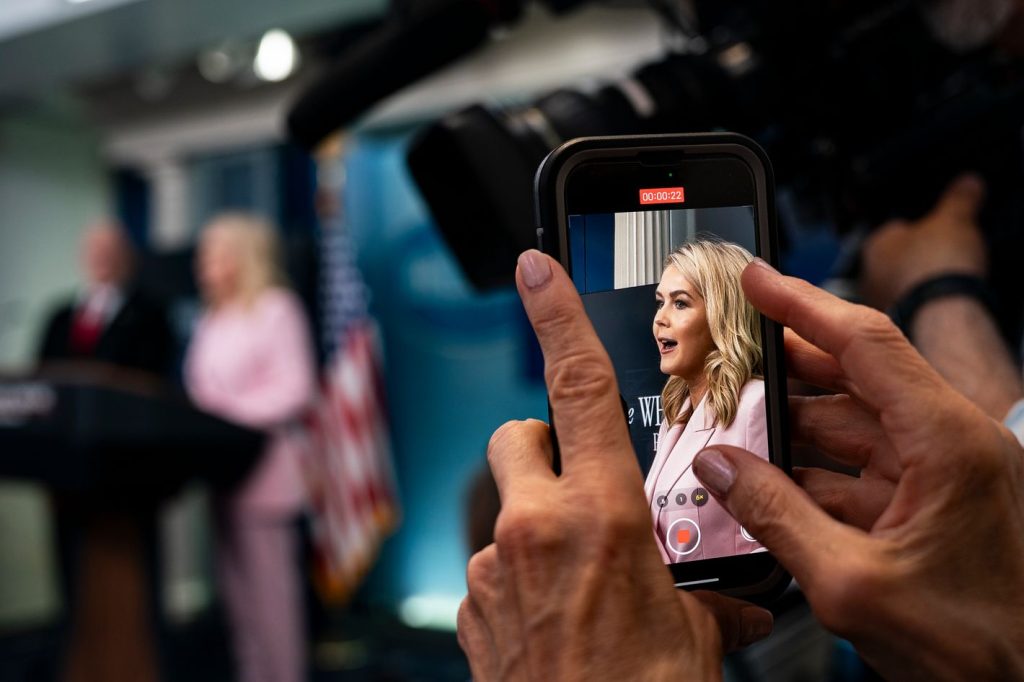Photo: Al Drago/The Washington Post/Getty Images
The Trump administration does not want to answer difficult questions. This was true the first time around, in the chaos and haze of the 2010s, and it’s true once more — except their contempt for the mainstream media appears to be reaching fresh, disorienting heights. Earlier this month, Karoline Leavitt, the White House press secretary, began convening special question-and-answer sessions for MAGA influencers. Gone, for a moment at least, were any of the professional journalists who might have played a watchdog role in the briefing room. They weren’t proper propagandists. They had no role to play.
“Congrats on 100 incredible days!” said one of the MAGA faithful, beaming. Another gushed that the 27-year-old Leavitt was an “inspiration for Gen Z.” One ardent Trumper, Arynne Wexler, quipped, “I can attest to the deportations in Florida; my Uber drivers finally speak English again.”
All of it makes a mockery of the idea of a free press that holds the federal government accountable, but that is where our political culture is headed. Trust in the mainstream media has plummeted — not for entirely unjustified reasons — and more and more Americans are polarized on Team Red or Team Blue, devouring curated news that reifies their own worldviews. It’d be easy to proclaim that Leavitt’s MAGA briefings are utterly unprecedented, a Trumpian assault on democracy as we know it, but the challenge actually runs much deeper. If the Biden administration and the Democrats broadly were less hostile to conventional journalists when they were in power, they too wanted to play the influencer game. They longed to dodge well-informed journalists asking challenging questions.
At the Democratic National Convention last summer, fewer seats and workspaces were handed out to traditional reporters. Instead, left-leaning digital influencers were allowed to run roughshod over the convention, lobbing softball questions at Democrats still delirious over the nomination of Kamala Harris. The only upside of it all, perhaps, was the rise of an internet comedian, Lionel McGloin, who posed as a giddy liberal influencer and strung together a viral segment of Borat-like bits that made a mockery of the Democrats that week. McGloin, known as No Cap on God, still amuses me to no end.
The trouble is most of these influencers, right and left, aren’t explicit comedians. They blend news and entertainment, existing to flatter their audience and aggregate news that working reporters still have to gather. Sharp commentary can be useful, and pundits have a role to play in any news ecosystem, but the puffing up of influencers is a naked end run around accountability journalism. Trump himself, at least, will sit for the occasional adversarial interview with a mainstream outlet — he does this more than Biden, who was slipping into senescence as his term wore on, ever did. But largely, Republicans resent any journalist who is not going to toe the MAGA line.
The influencer era in the White House took off under Biden. None of his press secretaries singled out influencers as much as Leavitt has, but the door was kicked open for the current spectacle. Last year, the Biden White House hosted a group of more than 100 influencers, from chefs and makeup artists to fitness gurus and medical students. Biden himself stopped by to tell the assemblage in the Indian Treaty Room in the White House complex that “the fact is, you are the future.” Biden also sat for a mostly pointless interview with Daniel Mac, a very popular influencer who asks drivers of nice cars what they do for a living. The Biden administration reportedly considered handing over a White House briefing room to influencers.
For traditional media outlets, it’s crucial to understand the battle lines have been drawn and will stay that way. Democratic and Republican politicians alike would rather insulate themselves whenever possible. An influencer will, in many instances, uncritically reproduce whatever message the politician disseminates. And if they don’t, they won’t be in the inner sanctum. It’s not as if the Biden administration was eager to invite the many young TikTokers who were despairing over the war in Gaza and blaming Biden for not reigning in the Israeli government. A MAGA-skeptical content creator is not getting the chance to grill Leavitt any time soon.
Journalists should recognize, too, the limits of access. If Leavitt has made the White House briefing into a farce — and the Biden administration laid the groundwork for where we are now — it’s important to remember most news isn’t going to be made with questions aimed at an administration mouthpiece. With Trump in particular, it’s never entirely clear who speaks for the administration, given its warring factions and the president’s own erratic behavior. The best reporting happens beyond the briefing room, and there’s no reason important reporting needs to happen with spin from the White House. The strongest investigative reporters know this already. Even in an influencer’s world, they’re still desperately needed.

